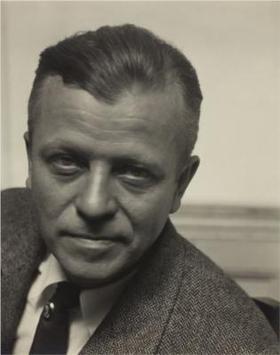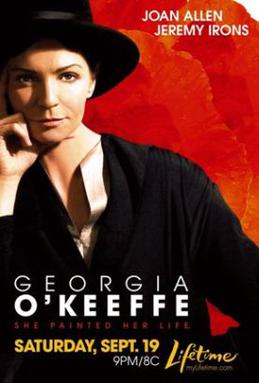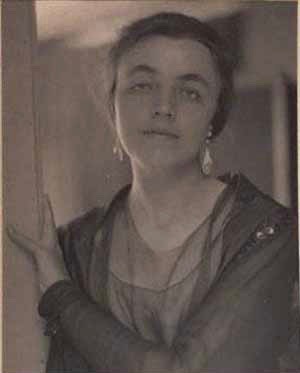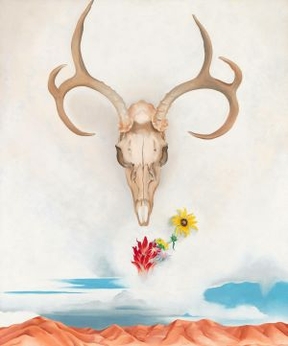
Georgia Totto O'Keeffe was an American modernist painter and draftswoman whose career spanned seven decades and whose work remained largely independent of major art movements. Called the "Mother of American modernism", O'Keeffe gained international recognition for her meticulous paintings of natural forms, particularly flowers and desert-inspired landscapes, which were often drawn from and related to places and environments in which she lived.

Alfred Stieglitz was an American photographer and modern art promoter who was instrumental over his 50-year career in making photography an accepted art form. In addition to his photography, Stieglitz was known for the New York art galleries that he ran in the early part of the 20th century, where he introduced many avant-garde European artists to the U.S. He was married to painter Georgia O'Keeffe.

Arthur Garfield Dove was an American artist. An early American modernist, he is often considered the first American abstract painter. Dove used a wide range of media, sometimes in unconventional combinations, to produce his abstractions and his abstract landscapes. Me and the Moon from 1937 is a good example of an Arthur Dove abstract landscape and has been referred to as one of the culminating works of his career. Dove made a series of experimental collages in the 1920s. He also experimented with techniques, combining paints like hand mixed oil or tempera over a wax emulsion as exemplified in Dove's 1938 painting Tanks, in the collection of the Boston Museum of Fine Arts.
American modernism, much like the modernism movement in general, is a trend of philosophical thought arising from the widespread changes in culture and society in the age of modernity. American modernism is an artistic and cultural movement in the United States beginning at the turn of the 20th century, with a core period between World War I and World War II. Like its European counterpart, American modernism stemmed from a rejection of Enlightenment thinking, seeking to better represent reality in a new, more industrialized world.

Susan Charna Rothenberg was an American contemporary painter, printmaker, sculptor, and draughtswoman. She became known as an artist through her iconic images of the horse, which synthesized the opposing forces of abstraction and representation.

Georgia O'Keeffe is a 2009 American television biographical drama film, produced by City Entertainment in association with Sony Television, about noted American painter Georgia O'Keeffe and her husband, photographer Alfred Stieglitz. The film was directed by Bob Balaban, executive-produced by Joshua D. Maurer, Alixandre Witlin and Joan Allen, and line-produced by Tony Mark. Shown on Lifetime Television, it starred Joan Allen and Jeremy Irons in lead roles.

Blue and Green Music is a 1919–1921 painting by the American painter Georgia O'Keeffe.

Katharine Nash Rhoades was an American painter, poet and illustrator born in New York City. She was also a feminist.

Marion Hasbrouck Beckett was an American painter.
Rebecca Salsbury James (1891–1968) was a self-taught American painter, born in London, England of American parents who were traveling with the Buffalo Bill Wild West Show. She settled in New York City, where she married photographer Paul Strand. Following her divorce from Strand, James moved to Taos, New Mexico where she fell in with a group that included Mabel Dodge Luhan, Dorothy Brett, and Frieda Lawrence. In 1937 she married William James, a businessman from Denver, Colorado who was then operating the Kit Carson Trading Company in Taos. She remained in Taos until her death in 1968.

Georgia O'Keeffe made a number of Red Canna paintings of the canna lily plant, first in watercolor, such as a red canna flower bouquet painted in 1915, but primarily abstract paintings of close-up images in oil. O'Keeffe said that she made the paintings to reflect the way she herself saw flowers, although others have called her depictions erotic, and compared them to female genitalia. O'Keeffe said they had misconstrued her intentions for doing her flower paintings: "Well – I made you take time to look at what I saw and when you took time to really notice my flower you hung all your own associations with flowers on my flower and you write about my flower as if I think and see what you think and see of the flower – and I don't."

Charcoal drawings by Georgia O'Keeffe from 1915 represents Georgia O'Keeffe's first major exploration of abstract art and attainment of a freedom to explore her artistic talents based upon what she felt and envisioned. O'Keeffe developed radical charcoal drawings, with just a few lines, that led to greater development of total abstraction. This series of works was completed following three summers of instruction at the University of Virginia on Arthur Wesley Dow's design philosophies, which were highly influential in her development as an abstract artist. Early the following year, photographer and art dealer, Alfred Stieglitz exhibited some of the drawings at his 291 art gallery.
Light Coming on the Plains is the name of three watercolor paintings made by Georgia O'Keeffe in 1917. They were made when O'Keeffe was teaching at West Texas State Normal College in Canyon, Texas. They reflect the evolution of her work towards pure abstraction, and an early American modernist landscape. It was unique for its time. Compared to Sunrise that she painted one year earlier, it was simpler and more abstract.

Black Iris, formerly called Black Iris III, is a 1926 oil painting by Georgia O'Keeffe. Art historian Linda Nochlin interpreted Black Iris as a morphological metaphor for female genitalia. O'Keeffe rejected such interpretations in a 1939 text accompanying an exhibition of her work, in which she wrote: "Well—I made you take time to look at what I saw and when you took time to really notice my flower you hung all your own associations with flowers on my flower and you write about my flower as if I think and see what you think and see of the flower—and I don't." She attempted to do away with sexualized readings of her work by adding a lot of detail.

Georgia O'Keeffe created a series of paintings of skyscrapers in New York City between 1925 and 1929. They were made after O'Keeffe moved with her new husband into an apartment on the 30th floor of the Shelton Hotel, which gave her expansive views of all but the west side of the city. She expressed her appreciation of the city's early skyscrapers that were built by the end of the 1920s. One of her most notable works, which demonstrates her skill at depicting the buildings in the Precisionist style, is the Radiator Building—Night, New York, of the American Radiator Building.

The American artist Georgia O'Keeffe is best known for her close-up, or large-scale flower paintings, which she painted from the mid-1920s through the 1950s. She made about 200 paintings of flowers of the more than 2,000 paintings that she made over her career. One of her paintings, Jimson Weed, sold for $44.4 million, making it the most expensive painting sold of a female artist's work as of 2014.
Georgiana Uhlyarik-Nicolae, also known as Georgiana Uhlyarik is a Romanian-born Canadian art curator, art historian, and teacher. She is currently the Fredrik S. Eaton Curator of Canadian Art at the Art Gallery of Ontario (AGO). She has been part of the team or led teams that created numerous exhibitions, on subjects such as Betty Goodwin, Michael Snow, and Kathleen Munn among others and collaborated with art organizations such as the Tate Modern, and the Jewish Museum, New York.

Summer Days is a 1936 oil painting by the American 20th-century artist Georgia O'Keeffe. It depicts a buck deer skull with large antlers juxtaposed with a vibrant assortment of wildflowers hovering below. The skull and flowers are suspended over a mountainous desert landscape occupying the lower part of the composition. Summer Days is among several landscape paintings featuring animal skulls and inspired by New Mexico desert O'Keeffe completed between 1934 and 1936.

Sky Above Clouds (1960–1977) is a series of eleven cloudscape paintings by the American modernist painter Georgia O'Keeffe, produced during her late period. The series of paintings is inspired by O'Keeffe's views from her airplane window during her frequent air travel in the 1950s and early 1960s when she flew around the world. The series begins in 1960 with Sky Above the Flat White Cloud II, the start of a minimalist cycle of six works, with O'Keeffe trying to replicate the view of a solid white cloud she saw while flying back to New Mexico. She would continue to work on this singular motif in Sky with Flat White Cloud, Clouds 5/ Yellow Horizon and Clouds, Sky with Moon, and Sky Above Clouds / Yellow Horizon and Clouds. A darker variation of this motif occurred in 1972, influenced by her battle with macular degeneration, resulting in The Beyond, her last, unassisted painting before losing her eyesight.
American artist Georgia O'Keeffe (1887–1986) created a series of 20 paintings and 14 photographs based on her more than nine-week visit to four of the Hawaiian Islands in the Territory of Hawaii in the summer of 1939. Her trip was part of an all-expenses paid commercial art commission from the Philadelphia advertising firm N. W. Ayer & Son on behalf of the Hawaiian Pineapple Company, later known as Dole. The company arranged for O'Keeffe to paint two works, without any artistic restrictions, for a magazine advertising campaign for pineapple juice. Two of the paintings from this commission, Crab's Claw Ginger Hawaii and Pineapple Bud, were used in advertisements that appeared in popular American magazines in 1940. Her photos of Hawaii are said to be her first major works in that medium up to that point.















